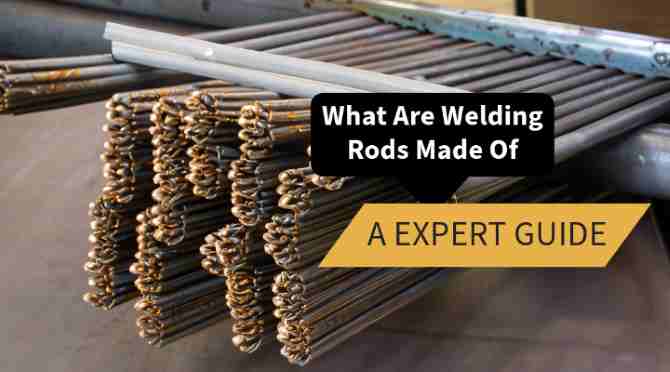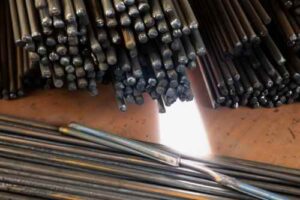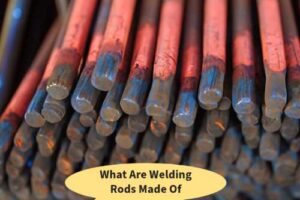Table of Contents
Welding is a fundamental process in the world of manufacturing, construction, and various industries. It involves joining materials, often metals, by melting their edges and fusing them together. Central to this process is welding rods, also known as welding electrodes, which serve as the filler material that creates the bond between the two pieces being welded. But have you ever wondered what welding rods are made of? In this comprehensive guide, we’ll take a deep dive into the intricate composition of welding rods, shedding light on the key components that make welding possible.
Introduction to What Are Welding Rods Made Of
Welding Rods: Behind Every Strong Weld Lies a Special Composition
Welding rods are integral to the welding process, acting as the bridge that connects two metal pieces. Their composition plays a pivotal role in determining the quality, strength, and durability of the weld. Let’s explore the various materials and elements that makeup welding rods, ensuring secure and successful welds.
What Are Welding Rods Made Of?
Welding rods are carefully crafted using a combination of materials that facilitate the welding process and contribute to the strength of the weld joint. The primary components of welding rods include:
1. Core Wire
At the heart of a welding rod lies the core wire. This wire serves as the main structural element of the rod and is responsible for carrying the electrical current that generates the heat needed to melt the filler material and the base metals. Core wires are typically made of low-carbon steel or alloyed steel, as they offer excellent conductivity and mechanical properties.
2. Flux Coating
Surrounding the core wire is the flux coating, a crucial element that serves multiple functions during welding. The flux coating is a combination of minerals and compounds that are carefully selected to provide shielding, arc stability, and protection from atmospheric contaminants. Common minerals found in flux coatings include titanium dioxide, calcium fluoride, and silica. The flux coating also produces a shielding gas when heated, preventing oxidation and ensuring a clean weld bead.
3. Alloy Additives
To enhance the performance and properties of the weld, various alloy additives are incorporated into the core wire. These additives can include elements such as manganese, nickel, chromium, and molybdenum. Depending on the desired characteristics of the weld, specific alloys are chosen to improve tensile strength, corrosion resistance, and other attributes.
4. Binder Material
The binder material is used to hold the core wire and flux coating together, maintaining the rod’s structural integrity during the welding process. Binders are typically made of cellulose, sodium silicate, or other binders that dissolve or decompose when heated, releasing the flux coating and creating a protective gas.
Exploring the Types of Welding Rods and Their Compositions
Welding rods come in various types, each designed for specific welding applications and materials. The composition of these rods varies to suit the intended purpose:
1. Mild Steel Welding Rods
Mild steel welding rods are among the most common types used in welding. These rods consist of a core wire made of mild steel and a flux coating that provides essential shielding and arc stability. The flux coating often contains compounds that produce a steady stream of protective gas, preventing contamination and ensuring a clean weld.
2. Stainless Steel Welding Rods
Stainless steel welding rods are formulated to weld stainless steel, a material known for its resistance to corrosion. These rods contain alloy additives such as chromium and nickel to enhance the weld’s corrosion resistance while maintaining its structural integrity.
3. Aluminum Welding Rods
Aluminum welding rods are specially crafted to weld aluminum and its alloys. These rods have a core wire made of aluminum and a flux coating designed to protect the weld from atmospheric gases. Silicon alloy additives are often included to improve fluidity and reduce cracking.
Which Materials Used in Welding Rods
The materials used in welding rods are selected with precision to ensure optimal performance in diverse welding applications. Common materials that are used in welding rods include:
- Mild Steel: Mild steel welding rods are the most versatile and widely used. They contain a mixture of iron and a small percentage of carbon. These rods are suitable for various applications, from general repairs to structural welding.
- Stainless Steel: Stainless steel welding rods are designed for welding stainless steel components. These rods incorporate chromium, which enhances the rods’ corrosion resistance and durability.
- Cast Iron: Welding cast iron requires specialized rods that can withstand the material’s high heat and brittleness. Cast iron welding rods often contain a combination of nickel and iron.
- Aluminum: Aluminum welding rods are used for joining aluminum materials. These rods contain aluminum as the primary component, along with other trace elements to improve weldability.
Unveiling the Components of Arc Rods
Arc rods, also known as arc welding electrodes, are a specialized type of welding rod designed for arc welding processes. These rods are characterized by their unique composition:
- Core Wire: The core wire of arc rods is tailored to the specific welding requirements. It can include materials such as mild steel, stainless steel, or other alloys.
- Flux Coating: The flux coating of arc rods is formulated to stabilize the arc, prevent contamination, and facilitate the welding process. The composition of the flux coating varies according to the type of welding and the base materials being joined.
Exploring Welding Rod Types
Welding rods come in a variety of types, each designed for specific applications. The four main types of welding rods are:
- Consumable Electrodes: These rods are consumed during the welding process, providing the filler material that joins the base metals. They are commonly used in Shielded Metal Arc Welding (SMAW) or Stick Welding.
- Non-Consumable Electrodes: These rods do not melt during welding and are used to create the welding arc. They are often employed in Tungsten Inert Gas (TIG) welding.
- Flux-Cored Electrodes: These electrodes have a hollow core filled with flux. They are used in Flux-Cored Arc Welding (FCAW) and are suitable for various metals and applications.
- Submerged Arc Welding Electrodes: These rods are used in Submerged Arc Welding (SAW), where the arc is shielded by a layer of granular flux.
FAQs About Welding Rod Composition
Are all welding rods made from steel?
No, welding rods come in various compositions to accommodate different materials. While steel welding rods are common, there are also rods designed for welding stainless steel, aluminum, and other metals.
Why is the flux coating important in welding rods?
The flux coating serves as a multi-functional element. It provides shielding to prevent oxidation, stabilizes the welding arc, and generates a protective gas that ensures a clean and reliable weld.
Can welding rod composition affect the strength of the weld?
Absolutely. The composition of the welding rod directly impacts the strength, corrosion resistance, and other properties of the weld. Selecting the right rod for the specific application is crucial for achieving the desired results.
What role do alloy additives play in welding rods?
Alloy additives are incorporated to enhance specific properties of the weld. Elements like chromium, nickel, and manganese contribute to characteristics such as corrosion resistance, tensile strength, and overall durability.
How does the binder material work in welding rods?
The binder material holds the core wire and flux coating together. During the welding process, the binder dissolves or decomposes, releasing the flux coating and creating a protective gas that shields the weld from contaminants.
Can I use any welding rod for any type of welding?
It’s essential to match the welding rod’s composition with the material you’re welding. Using the appropriate rod ensures that the weld joint possesses the required strength, properties, and integrity.
How It Is Made – Welding Electrodes
Conclusion: Crafting Bonds with Precision and Expertise
As we’ve delved into the composition of welding rods, it’s evident that these seemingly simple components are the result of careful engineering and expertise. The combination of core wire, flux coating, alloy additives, and binder material creates a welding rod capable of producing strong, reliable welds across various applications. Whether you’re welding mild steel, stainless steel, or aluminum, understanding the role of welding rod composition is key to achieving successful and lasting welds.
So, the next time you witness a seamless bond-forming through the power of welding, you’ll have a deeper appreciation for the intricate science and artistry behind the process.



5 thoughts on “What Are Welding Rods Made Of”